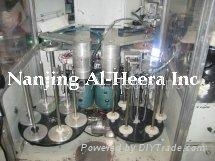DL is a DVD that instead of having a single recordable layer on a poly carbonate base, it has two recordable layers between bases with a clear separator in the middle. It's not double-sided--the grooves on both layers are pointed in the same direction, so the single laser in your DVD player can actually look through the first layer to focus on the second one. Because it only has to be read from one side, a dual layer DVD can be identified and read by a normal DVD player.
A DVD can hold digital information on both sides of the disc and in two sandwiched layers on each side. A dual-layered disc can, for example, offer a movie in both widescreen and full-screen (or pan-and-scan) formats, and your DVD player can switch from one layer to another with a barely perceptible interruption in playback. Dual-layered DVDs are also useful for holding longer films (such as Titanic and Saving Private Ryan) or video games that exceed the capacity of a single layer.
Most DVDs will be properly labeled to indicate if they are dual-layered. (You can also identify a dual-layered DVD by its golden-colored data side, as opposed to the shiny silver of a single-layered disc.) There are two types of dual-layered DVDs--PTP and OTP (also known as RSDL). The PTP (or "parallel track path") configuration allows a DVD player's laser to switch easily from layer to layer to access features like multiple menus, pop-up information, and other special effects. The OTP (for "opposite track path") configuration is more commonly referred to as RSDL (for "reverse spiral dual layer"), meaning that the DVD laser reads the first (top) layer outward from the center of the disc, then switches to the second (bottom) layer and continues to read the disc inward from the outer edge. On most DVD players, viewers will experience a slight pause as the player's laser switches from the top to bottom layer. In most cases, this pause is very brief and should not compromise the viewing experience.

